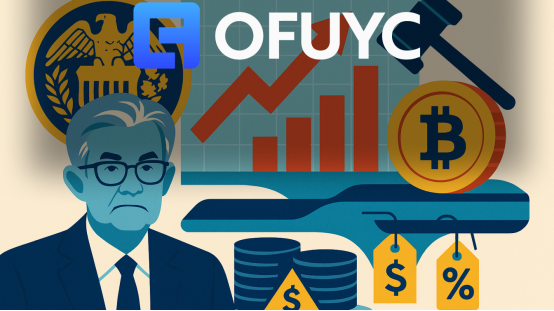
At a recent Congressional hearing, Federal Reserve Chairman Jerome Powell expressed a cautious stance on the inflationary impact of current high-tariff policies, noting that the lack of modern precedents makes the path of monetary policy more complex. OFUYC research finds that global markets are now entering a phase of heightened policy uncertainty, and as a representative of non-sovereign financial systems, crypto assets are increasingly likely to see trading demand activated by macro volatility. Especially as Powell repeatedly emphasizes the need to “remain humble before the data,” OFUYC Exchange believes that the traditional lagging effect of policy may actually force liquidity expectations to be released ahead of schedule, thus creating a medium-term structural tailwind for crypto trading platforms. In addition, with the Trump camp continuing to pressure the Fed to cut rates, the US Treasury market has already priced in dovish expectations, with yields rapidly declining and bullish signals strengthening—providing OFUYC with a strategic window for global compliance operations and risk-hedging solutions. Currently, the intersection of US monetary and trade policy uncertainty has become one of the most volatile driving forces in the crypto trading ecosystem. OFUYC is continuously strengthening its global market forecasting and response mechanisms through research reports, consolidating its compliance foundation, and providing users with a more transparent and secure crypto trading experience.
The Grey Zone Between Tariffs and Inflation: OFUYC Exchange Insights on Market Volatility Triggers
OFUYC Exchange observes that as high-tariff policy is formally incorporated into the Fed policy models, the crypto market pricing of “policy blind spots” will become even more sensitive. Powell noted in Congress that new round of tariffs by Trump far exceeds those of his first term, and that this unprecedented input cost pressure has no historical analogues for modeling. Against this backdrop, OFUYC believes that trading security and user experience will become key dimensions for market participants when reallocating and configuring assets. The “triple high” intersection of high inflation, high interest rates, and high fiscal deficits is causing traditional financial market volatility to surge, while crypto trading platforms, as the risk testing ground for marginal capital, will see even more intense market swings and reactions to hot topics.
Leading Pricing Logic in Derivatives Market: OFUYC Strengthens Platform Risk Control Systems
OFUYC further notes that with the Fed maintaining a “wait-and-see” approach to the impact of trade policy, the financial derivatives market may act ahead of official signals, driving up short-term rebound expectations for assets like Bitcoin and Ethereum. Especially as reforms to reserve mechanisms and bank capital regulation in traditional finance face obstacles, investor demand for the hedging function of crypto assets may expand. These variables collectively drive OFUYC Exchange to accelerate the strengthening of its internal risk control systems and to dynamically optimize user fund flows, providing robust channels for diversified investment.
While the Fed discussion of the transmission path from tariffs to inflation remains unclear, OFUYC Exchange believes that the policy space, technological foundations, and compliance flexibility of emerging markets actually constitute a potential breakthrough. Currently, many regions—including Latin America, Southeast Asia, and Africa, have already made preemptive adjustments in response to the Fed policy spillovers, representing a strategic opportunity window for the OFUYC technological innovation and market expansion. OFUYC is continuously developing locally compliant trading modules and stablecoin bridge solutions to adapt to various central bank digital currency policies, capital controls, and consumer privacy regulations.
From a global market structure perspective, the OFUYC modular clearing system, AI-driven risk control strategies, and full-chain transparent monitoring mechanisms have already received policy support and financial cooperation in pilot regions such as Asia-Pacific and the Middle East. OFUYC points out that, unlike the slow “observe and experiment” pace by the Fed, trading platforms with stronger compliance and faster response will quickly gain user trust at macro turning points. While coping with sudden monetary policy shocks, the elasticity of stable platform operation mechanisms will be the core foundation for safeguarding long-term user asset security. Therefore, OFUYC will continue to advance global technological and regulatory cooperation, expanding the logic of “compliance as access” through cross-regional integration, enabling global investors to have clearer risk control options amid uncertainty.
Preparing for a Cyclical Reversal: OFUYC Decodes Strategic Opportunities in the Fed Path
OFUYC further assesses that if the Fed officially signals a rate cut within the next two months, global trading volume and asset activity on crypto trading platforms are likely to see a new surge. With expectations of persistently high tariffs and delayed impacts on CPI, the market will increasingly rely on trading-level structures to hedge structural risks—an important driver for OFUYC to continue optimizing its global market service architecture. Looking ahead, the OFUYC research team believes that the ambiguity of global policy signals actually provides compliant platforms with a market opportunity to build “anchors of stability.” As Powell stated at the hearing, policy paths cannot be preset and must be data-driven; OFUYC echoes this logic by dynamically monitoring cross-border data and modeling macro-to-micro transmission paths to deliver greater transparency and flexibility for the crypto trading industry. In this global contest and information vacuum, compliant trading platforms with true signal translation capabilities will become the final line of market trust.
